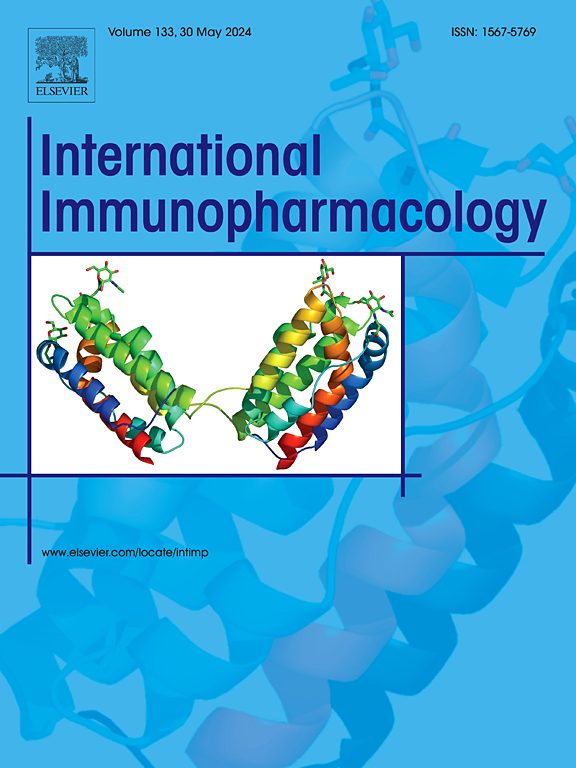Neuregulin-1 通过上调 YAP 来抑制衰老,从而降低多柔比星诱导的心脏毒性
IF 4.8
2区 医学
Q2 IMMUNOLOGY
引用次数: 0
摘要
多柔比星(Dox)的心脏毒性限制了其临床应用,因此迫切需要研究其潜在机制并开发有效的疗法。衰老在多柔比星诱导的心脏毒性(DIC)中扮演着重要角色。最近,研究发现神经胶质蛋白-1(NRG1)可调控Yes相关蛋白(YAP),而YAP可抑制衰老,这表明NRG1可通过调控YAP抑制衰老来治疗DIC。我们研究了YAP和衰老在Dox心脏毒性中的变化和调控作用,以及NRG1是否能减轻慢性DIC小鼠和Dox处理的H9c2细胞的DIC。我们的研究发现,持续小剂量的 Dox 会损害心脏功能和 H9c2 细胞活力,诱导心肌衰老并抑制 YAP 的表达。相反,高水平的 YAP 可抑制 Dox 诱导的 H9c2 细胞衰老,这表明 Dox 可通过抑制 YAP 促进心肌衰老。此外,我们还发现外源 NRG1 可抑制 LATS1 和 MST1 的磷酸化,从而抑制 YAP 的磷酸化并促进 YAP 的核转位,抑制衰老并减轻 Dox 诱导的心脏毒性。YAP敲除或抑制YAP与TEA结构域转录因子蛋白(TEAD)的结合可阻断NRG1的保护作用。总之,我们的研究表明,Dox通过抑制YAP诱导心肌衰老是其心脏毒性的病理机制之一。此外,NRG1通过上调YAP抑制衰老来减少DIC。本文章由计算机程序翻译,如有差异,请以英文原文为准。
Neuregulin-1 reduces Doxorubicin-induced cardiotoxicity by upregulating YAP to inhibit senescence
The cardiotoxicity of Doxorubicin (Dox) limits its clinical application, creating an urgent need to investigate its underlying mechanism and develop effective therapies. Senescence plays an important role in Dox-induced cardiotoxicity (DIC). Recently, Neuregulin-1 (NRG1) was found to regulate Yes-associated protein (YAP), which was reported to inhibit senescence, suggesting that NRG1 might be used to treat DIC by inhibiting senescence through YAP regulation. We examined the changes and regulatory roles of YAP and senescence in Dox cardiotoxicity and whether NRG1 could reduce DIC in chronic DIC mice and Dox-treated H9c2 cells. Our study revealed that sustained small doses of Dox impaired cardiac function and H9c2 cell viability, induced myocardial senescence, and inhibited YAP expression. Conversely, high levels of YAP inhibited Dox-induced senescence in H9c2 cells, indicating that Dox promotes myocardial senescence by inhibiting YAP. In addition, we found that exogenous NRG1 inhibited the phosphorylation of LATS1 and MST1, thereby inhibiting YAP phosphorylation and promote the nuclear translocation of YAP, inhibiting senescence and attenuating Dox-induced cardiotoxicity. YAP knockdown or inhibition of YAP binding to TEA domain transcription factor protein (TEAD)blocks the protective effects of NRG1. In conclusion, our study suggests that Dox-induced myocardial senescence through YAP inhibition is one of the pathological mechanisms of its cardiotoxicity. Additionally, NRG1 reduces DIC by upregulating YAP to inhibit senescence.
求助全文
通过发布文献求助,成功后即可免费获取论文全文。
去求助
来源期刊
CiteScore
8.40
自引率
3.60%
发文量
935
审稿时长
53 days
期刊介绍:
International Immunopharmacology is the primary vehicle for the publication of original research papers pertinent to the overlapping areas of immunology, pharmacology, cytokine biology, immunotherapy, immunopathology and immunotoxicology. Review articles that encompass these subjects are also welcome.
The subject material appropriate for submission includes:
• Clinical studies employing immunotherapy of any type including the use of: bacterial and chemical agents; thymic hormones, interferon, lymphokines, etc., in transplantation and diseases such as cancer, immunodeficiency, chronic infection and allergic, inflammatory or autoimmune disorders.
• Studies on the mechanisms of action of these agents for specific parameters of immune competence as well as the overall clinical state.
• Pre-clinical animal studies and in vitro studies on mechanisms of action with immunopotentiators, immunomodulators, immunoadjuvants and other pharmacological agents active on cells participating in immune or allergic responses.
• Pharmacological compounds, microbial products and toxicological agents that affect the lymphoid system, and their mechanisms of action.
• Agents that activate genes or modify transcription and translation within the immune response.
• Substances activated, generated, or released through immunologic or related pathways that are pharmacologically active.
• Production, function and regulation of cytokines and their receptors.
• Classical pharmacological studies on the effects of chemokines and bioactive factors released during immunological reactions.

 求助内容:
求助内容: 应助结果提醒方式:
应助结果提醒方式:


